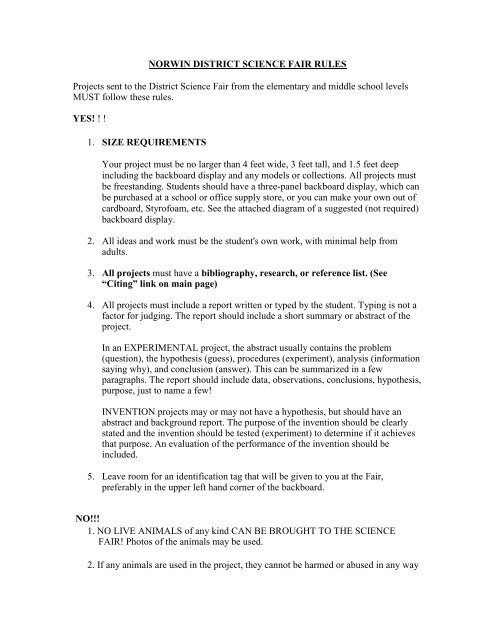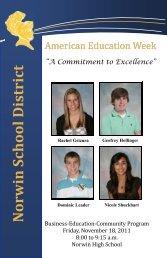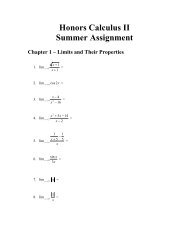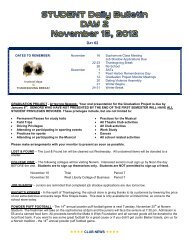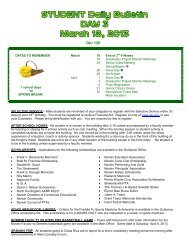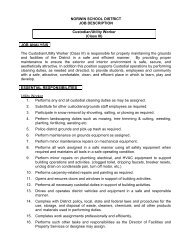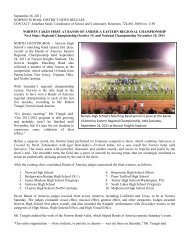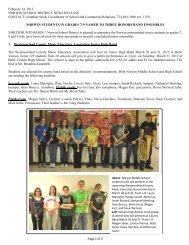Science fair rules 2013 - Norwin School District
Science fair rules 2013 - Norwin School District
Science fair rules 2013 - Norwin School District
You also want an ePaper? Increase the reach of your titles
YUMPU automatically turns print PDFs into web optimized ePapers that Google loves.
NORWIN DISTRICT SCIENCE FAIR RULES<br />
Projects sent to the <strong>District</strong> <strong>Science</strong> Fair from the elementary and middle school levels<br />
MUST follow these <strong>rules</strong>.<br />
YES! ! !<br />
1. SIZE REQUIREMENTS<br />
Your project must be no larger than 4 feet wide, 3 feet tall, and 1.5 feet deep<br />
including the backboard display and any models or collections. All projects must<br />
be freestanding. Students should have a three-panel backboard display, which can<br />
be purchased at a school or office supply store, or you can make your own out of<br />
cardboard, Styrofoam, etc. See the attached diagram of a suggested (not required)<br />
backboard display.<br />
2. All ideas and work must be the student's own work, with minimal help from<br />
adults.<br />
3. All projects must have a bibliography, research, or reference list. (See<br />
“Citing” link on main page)<br />
4. All projects must include a report written or typed by the student. Typing is not a<br />
factor for judging. The report should include a short summary or abstract of the<br />
project.<br />
In an EXPERIMENTAL project, the abstract usually contains the problem<br />
(question), the hypothesis (guess), procedures (experiment), analysis (information<br />
saying why), and conclusion (answer). This can be summarized in a few<br />
paragraphs. The report should include data, observations, conclusions, hypothesis,<br />
purpose, just to name a few!<br />
INVENTION projects may or may not have a hypothesis, but should have an<br />
abstract and background report. The purpose of the invention should be clearly<br />
stated and the invention should be tested (experiment) to determine if it achieves<br />
that purpose. An evaluation of the performance of the invention should be<br />
included.<br />
5. Leave room for an identification tag that will be given to you at the Fair,<br />
preferably in the upper left hand corner of the backboard.<br />
NO!!!<br />
1. NO LIVE ANIMALS of any kind CAN BE BROUGHT TO THE SCIENCE<br />
FAIR! Photos of the animals may be used.<br />
2. If any animals are used in the project, they cannot be harmed or abused in any way
3. Group work is acceptable with no more than two (2) in a group. Both students must<br />
be from <strong>Norwin</strong> Middle <strong>School</strong> and both must submit an entry form.<br />
4. Dangerous chemicals and open flames are not permitted at the <strong>Science</strong> Fair.<br />
5. No plagiarizing (copying material from someone else without permission)<br />
6. Do NOT put your name, your own picture, or the name of your school on your<br />
project.<br />
7. No purchased models, such as the human body, will be judged.<br />
HELP! !<br />
For help, try the following:<br />
your science teacher<br />
any of the many books in the library about doing a <strong>Science</strong> Fair project<br />
the following web sites:<br />
http:/ /www.ipl.org/youth/project guide<br />
http://www.sciencebuddies.org/science-<strong>fair</strong>-projects/project_guide_index.shtml<br />
BASIC RULES AND SAFETY PROCEDURES<br />
All projects must be approved by the teacher/advisor before beginning.<br />
Only one exhibit is allowed per student or group. Projects which are a<br />
continuation of a previous exhibit must involve significant new experimentation.<br />
Student experimenters should wear safety goggles (eye protection), and follow<br />
standard safety practices when working with fire, hot liquids or caustic chemicals.<br />
Parent approva1 and supervision must be required for these projects<br />
All experiments using vertebrate animals or human subjects should cause no harm<br />
or undue stress to the subjects. Proper certification (form 2, 3, or 4) must first be<br />
completed prior to any investigation in these areas.<br />
No live vertebrate may be exhibited at the <strong>fair</strong> (models, toy animals, or<br />
photographs should be used instead). Exceptions may be granted with special<br />
permission.<br />
Students should avoid doing experiments involving bacterial cultures.<br />
Human parts other than teeth, hair, nails, histological sections and liquid tissue<br />
slides (properly acquired) should not be displayed.<br />
The use of controlled substances, (drugs, chemicals, anaesthetics, etc., regulated<br />
by the Comprehensive Drug Abuse Prevention and Control Act of 1970) must<br />
conform to existing local state and federal law. Such substances may not be<br />
exhibited.
No dangerous or combustible chemicals should be displayed. Rockets or engines<br />
must not contain fuel. All chemicals displayed should have the contents clearly<br />
marked on the container.<br />
No open or concealed flames are permitted. Devices producing temperatures in<br />
excess of 70°C must be adequately insulated.<br />
The following electrical safety <strong>rules</strong> must be observed:<br />
a. Wiring must be properly insulated and fastened.<br />
b. Household and high voltage circuits must include an adequate overload safety<br />
device.<br />
c. High voltage equipment must be shielded with a grounded metal cage or box<br />
to prevent accidental contact.<br />
d. Approved cords or switches must be used for circuits operating on 110 volts.<br />
Open knife switches are not acceptable for circuits exceeding 12 volts.<br />
e. Wet cell batteries with open tops are not permitted.<br />
f. Devices which generate dangerous rays (vacuum tubes, lasers, etc.) must be<br />
properly shielded. Only class I and II lasers may be operated at the exhibit.<br />
1. Must have a protective housing preventing access to them.<br />
2. Be operated only in the presence of the exhibitor and be connected<br />
when not in use.<br />
3. Be accompanied by adequate warning signs (i.e. “Danger! Laser<br />
radiation, do not look into beam!”)<br />
HOW TO PREPARE A SCIENCE PROJECT<br />
I. CHOOSING A SUBJECT<br />
A. Deciding what to do may be the most difficult part. Start by listing subjects<br />
you are interested in (i.e., football, sewing, chemistry, music, etc. See<br />
“<strong>Science</strong> Fair Ideas” link for more).<br />
B. From each general subject area, list questions that you think might be<br />
interesting to answer. Examples might be; "How does temperature affect air<br />
pressure in a football?"; "Which thread is stronger"; “How constant is the<br />
chlorine content of our drinking water?” or,’ How do the notes of a clarinet and<br />
saxophone differ?" Try to make your question as specific as possible.<br />
C. Finally, choose one that you think you can answer. Before choosing it, do some<br />
preliminary research and consider these three questions:<br />
II. PROJECT PROPOSAL<br />
1. Will it be interesting and safe?<br />
2. Can I get the necessary equipment or materials to do it?<br />
3. Will I have enough time to complete it?<br />
Once you have chosen) your problem, write out your project proposal. In your<br />
proposal you will list your problem and the materials and procedures you plan to<br />
use.<br />
Submit your proposal for approval to your teacher or advisor before you begin (if<br />
you change problems or procedures. you must submit a new proposal).
III. THE EXPERIMENT<br />
Once your proposal is approved, follow the time line on the web site.<br />
A. Research:<br />
1. First, find out as much as you can about your topic. Look up information in<br />
science books<br />
and magazines or interview a scientist or specialist in the area you are studying.<br />
B. State your hypothesis:<br />
1. This is sometimes called an "educated guess.” What do you think you will<br />
discover once your experiment is finished? Your hypothesis does not have to be<br />
correct, rather, you will be doing the experiment to test it and see if it was right. A<br />
sample hypothesis might be,” I expect the air pressure in a football to change by<br />
10% from the hottest day to the coldest day.”<br />
C. Begin Your Experiment:<br />
1. Make measurements and record your data in metric units whenever possible.<br />
2. Use a control when applicable.<br />
a. In the case above we will have two footballs. One will be heated and cooled.<br />
The other will remain at room temperature. The unaffected one is called the<br />
control and allows us to make sure that it is the heating and cooling of the other<br />
one that is causing the change in the pressure, and not some other factor (such as<br />
humidity or cosmic rays). Each time we measure pressure in our experimental<br />
sample we will also check the pressure in our control sample. By measuring the<br />
control, we will also see how much air is lost each time we insert the pressure<br />
gauge into the ball.<br />
3. Manage your variables properly. All external influences must stay the same<br />
(controlled variables) except the one you are testing (manipulated variable).<br />
a. In our sample experiment, we must use the same footballs, thermometer and<br />
pressure gauge each time and keep all other factors (humidity. etc.) constant. The<br />
only factor we will change is the temperature. We will heat the experimental ball<br />
in an oven and cool it in a freezer, then measure and record the pressure inside the<br />
ball.<br />
4. Have a sufficiently large sample size and perform your experiment more than<br />
once. If you do the same experiment ten times will the results be similar?<br />
Do you think all footballs will react the same way? Should you try other ones to<br />
be sure? Is it okay to compare footballs from different manufacturers?
5. Collect and present your results tables. Graphs and charts are helpful in<br />
evaluating data. You may have to do some statistical analysis to best evaluate<br />
your results (averages. means. medians modes standard deviations. etc.).<br />
6. From your results, form your conclusion. Was your original hypothesis correct?<br />
Can you do additional experiments to verify your results?<br />
a. An example might be to guess from your data what the pressure in a football<br />
will be at a temperature you haven’t yet tested<br />
It is also possible that you may have negative results<br />
b. For example, you may discover that the pressure doesn’t change in the<br />
football (from -10 degrees C to 35 degrees C). These results are to be reported<br />
and are perfectly acceptable!<br />
Remember that your results and your conclusion are a product of your<br />
experiment. Someone else may do the same experiment and get different results.<br />
You reduce this possibility by doing your experiment more than once.<br />
IV MAKING YOUR DISPLAY AND REPORT<br />
A. Follow the display guidelines given by your teacher/advisor. Make your display<br />
look interesting and present all information clearly. Plan ahead to be sure that all<br />
lettering and segments will fit.<br />
B. If a written report is required, follow the guidelines presented by your teacher.<br />
Remember to include your abstract.<br />
C. Students should maintain a journal or notebook of their observations. This is used<br />
to make observations and collect data. It can be considered a “rough draft” and<br />
should be cleaned up in the final report.<br />
D. Expensive or fragile items should not be displayed. Instead, use simulations,<br />
models or photographs. Items which are displayed in front of the backboard<br />
should be adequately secured (i.e., batteries, wire, switch, motor secured to a<br />
piece of plywood).<br />
E. Design your backboard for easy transport. Carefully pack all materials before<br />
transporting them to and from the <strong>fair</strong>.<br />
F. Have a photo taken of you and your project for your scrap book. Years later<br />
you’ll be glad you did!


